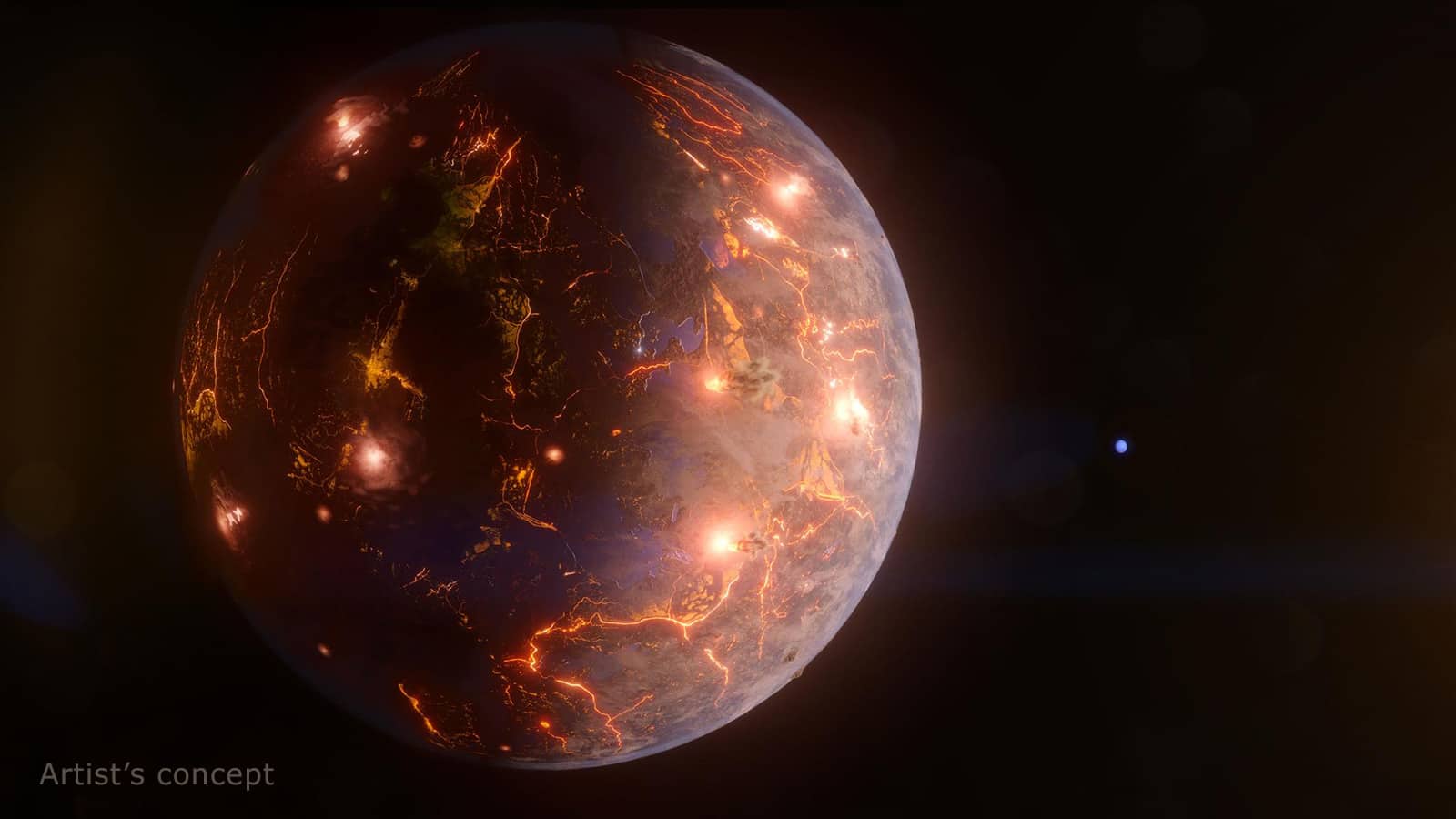Astronomers have discovered an Earth-sized exoplanet. But this planet is nothing like Earth. It’s tidally locked, always facing its star on the same side — perpetual day on one side, perpetual night on the other. The planet is also carpeted with volcanoes. In fact, it has so many volcanoes that eruptions could be fueling an atmosphere.

LP 791-18 d, as the planet is called, orbits a small red dwarf star that’s just a little larger than Jupiter. The system lies 90 light-years away from Earth, and actually features several interesting planets.
Funky planets
The innermost planet, (LP 791-18 b) is a super-Earth that takes just 0.9 days to complete a rotation around its star. It’s also very close to its star — but because the star is so small, it’s not that hot. The outermost planet (LP 791-18 c) is a “mini-Neptune”. It’s 7 times more massive than the Earth and takes 5 days to complete one orbit of its star — it also lies very close to its star. However, the middle planet, LP 791-18 d, is most interesting.
“LP 791-18 d is tidally locked, which means the same side constantly faces its star,” said Björn Benneke, a co-author and astronomy professor at iREx who planned and supervised the study. “The day side would probably be too hot for liquid water to exist on the surface. But the amount of volcanic activity we suspect occurs all over the planet could sustain an atmosphere, which may allow water to condense on the night side.”
The planet is too far away to actually see the volcanoes. Instead, researchers figured out they likely exist by comparing the planet to something similar in our solar system: Jupiter’s moon Io.
Io is the most volcanically-active place in the solar system. Because Io is so close, we can actually see the volcanoes and the traces of lava on the moon. We also know that this volcanism is actually caused by gravity: Io is caught in a constant gravitational tug-of-war with Jupiter. The moon’s main source of internal heat comes from the tidal forces generated by Jupiter’s gravitational pull, and that’s also what causes volcanoes on its surface. This was first predicted by researchers and then observed during the Voyager mission.
The same thing seems to be happening on LP 791-18 d. The planet passes very closely to the ‘c’ planet, the mini-Neptune. At their closest point, the two planets pass within 1.5 million kilometers of each other — that’s 33 times closer than Mars and the Earth get to each other. Each of these close passes produces a gravitational pull, shifting the planet’s orbit and causing it to bulge. This also generates heat (a process called tidal heating) — and, in all likelihood, it produces volcanoes like on Io.
But this is where it really gets interesting: the planet lies just on the inner fringe of the habitable zone.
Could this planet have water?
The habitable zone is the region around a star where researchers theorize that liquid water can exist. Around bigger stars, planets have to be farther away for this to happen. Around smaller stars, planets can be closer. In this case, if the planet has all the volcanic activity researchers expect it to have, then it could perhaps even maintain an atmosphere.
This is a pretty striking conclusion. After all, the planet is nothing like Earth — it’s got a ton of volcanoes, it’s tidally locked, and it’s closer to a smaller star. But it could have an atmosphere and liquid water. This makes it an excellent target for future study.
“A big question in astrobiology, the field that broadly studies the origins of life on Earth and beyond, is if tectonic or volcanic activity is necessary for life,” said co-author Jessie Christiansen, a research scientist at NASA’s Exoplanet Science Institute at Caltech in Pasadena. “In addition to potentially providing an atmosphere, these processes could churn up materials that would otherwise sink down and get trapped in the crust, including those we think are important for life, like carbon.”
Of course, none of this is actually confirmed now. But one thing’s for certain: this planet, and its entire system, is super interesting and definitely worth more attention from astronomers.
Another important takeaway is that a part of this discovery was made thanks to data from the Spitzer telescope — although it’s been decommissioned since 2020. This shows that even after their official runtime, astronomic missions can still offer valuable scientific information.
“It is incredible to read about the continuation of discoveries and publications years beyond Spitzer’s end of mission,” said Joseph Hunt, Spitzer project manager at NASA’s Jet Propulsion Laboratory in Southern California. “That really shows the success of our first-class engineers and scientists. Together they built not only a spacecraft but also a data set that continues to be an asset for the astrophysics community.”
The study was published in Nature.









